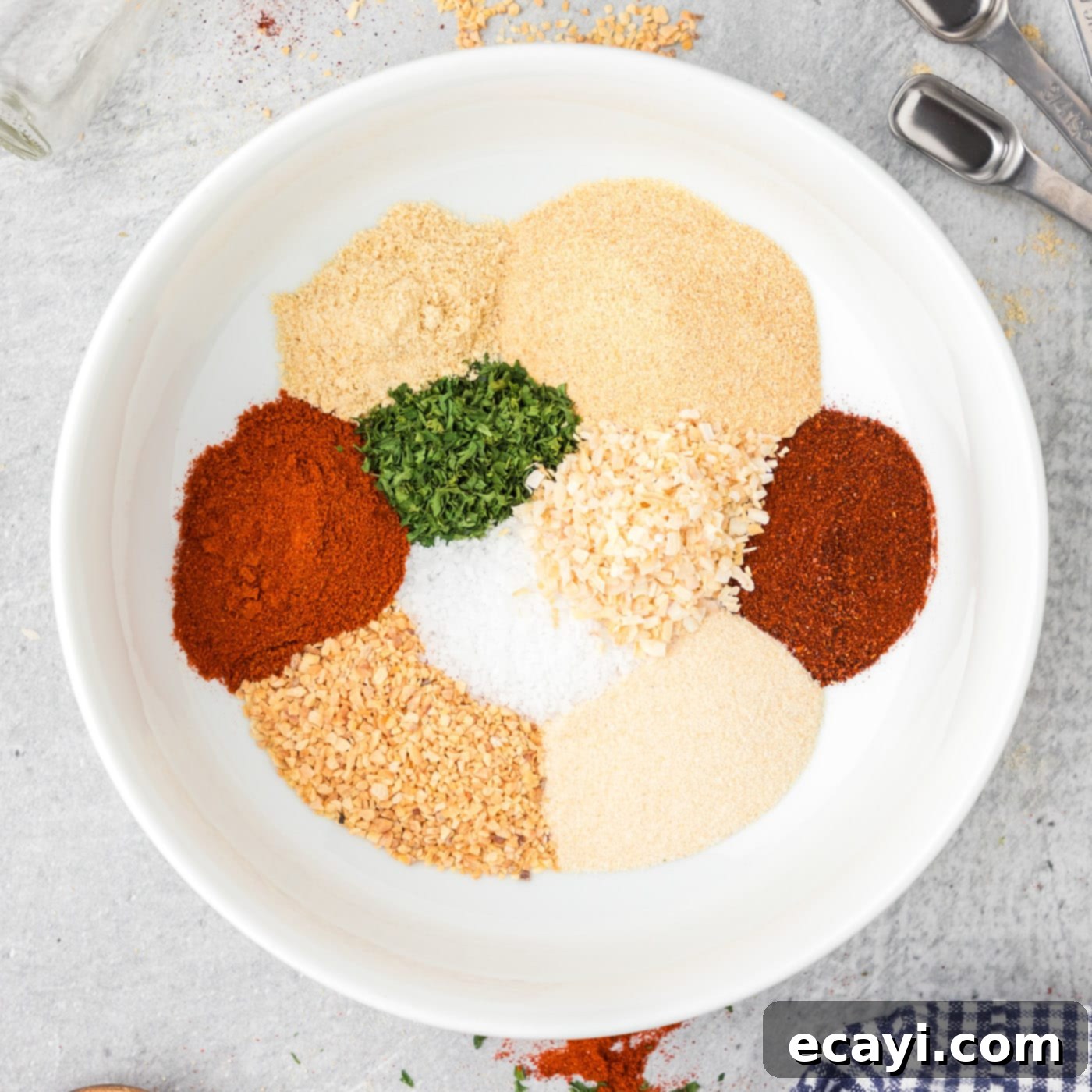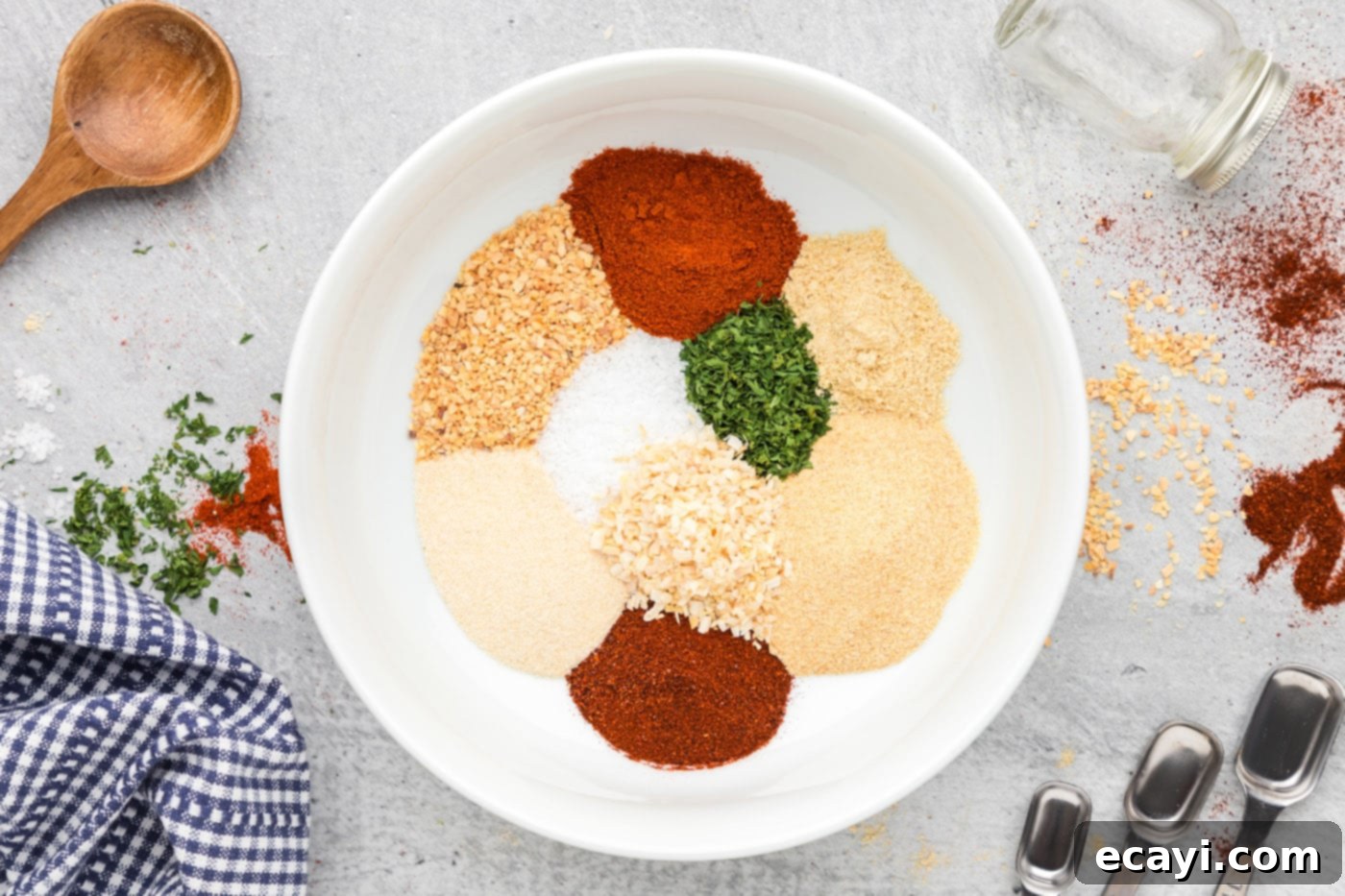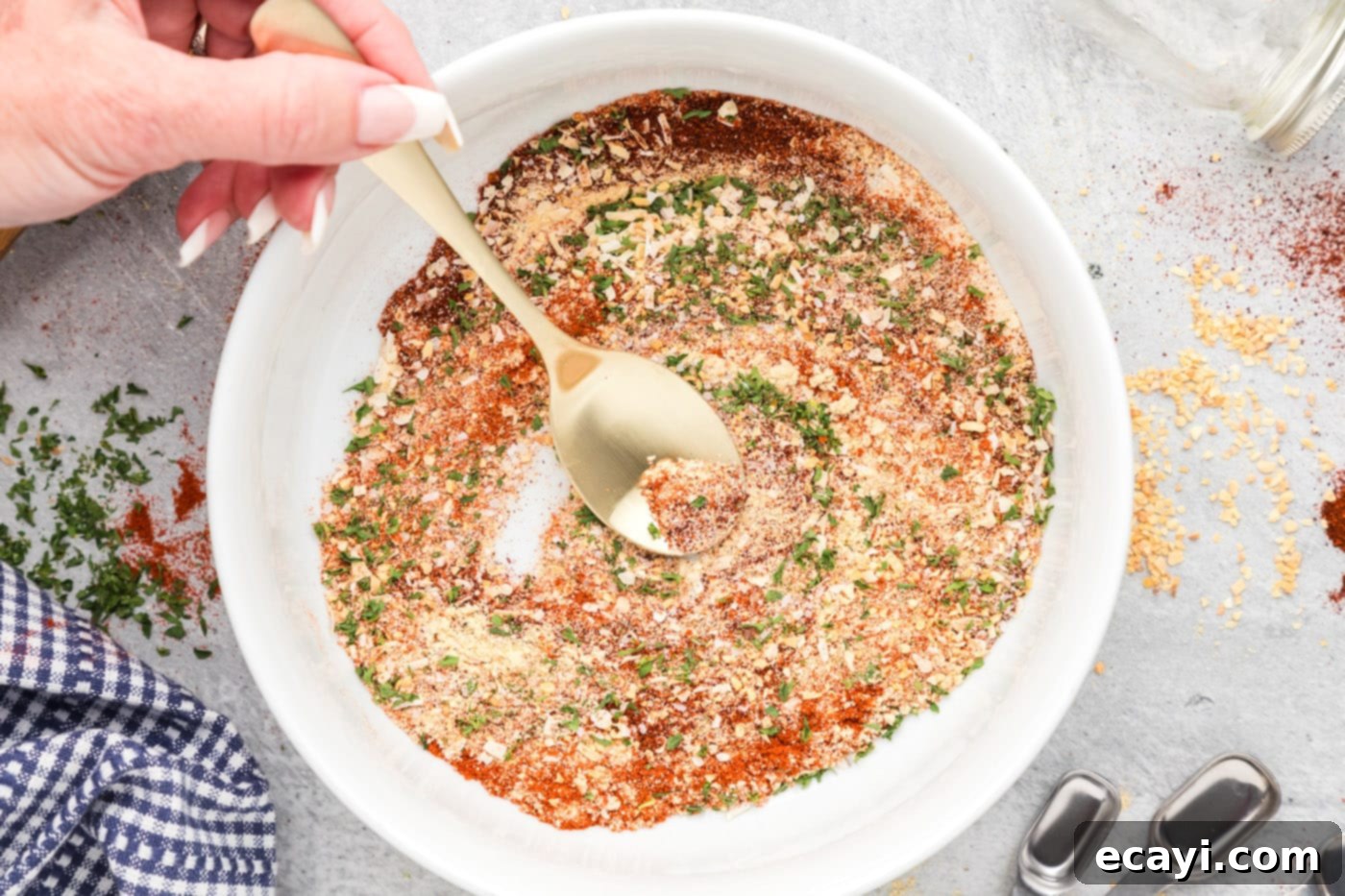Elevate Every Dish: Crafting Your Perfect Homemade All-Purpose Seasoning Blend
Imagine a single blend of aromatic spices and fragrant herbs that can transform any ordinary meal into a culinary masterpiece with just a sprinkle. Our homemade all-purpose seasoning blend is precisely that – a versatile flavor enhancer designed to effortlessly elevate your savory dishes. Forget the endless search through your spice rack for individual ingredients; this carefully curated mix comes together in minutes, offering an unparalleled depth of flavor that store-bought alternatives simply can’t match.
Crafting your own seasoning blends is not only incredibly rewarding but also remarkably simple. This easy-to-prep, ready-to-store staple is destined to become your kitchen’s best-kept secret. It’s an economical choice that allows you complete control over ingredients, ensuring no hidden fillers, excessive sodium, or artificial additives. From weeknight dinners to special occasions, this adaptable seasoning provides consistent, delicious results every time, making meal preparation faster, healthier, and infinitely more flavorful.
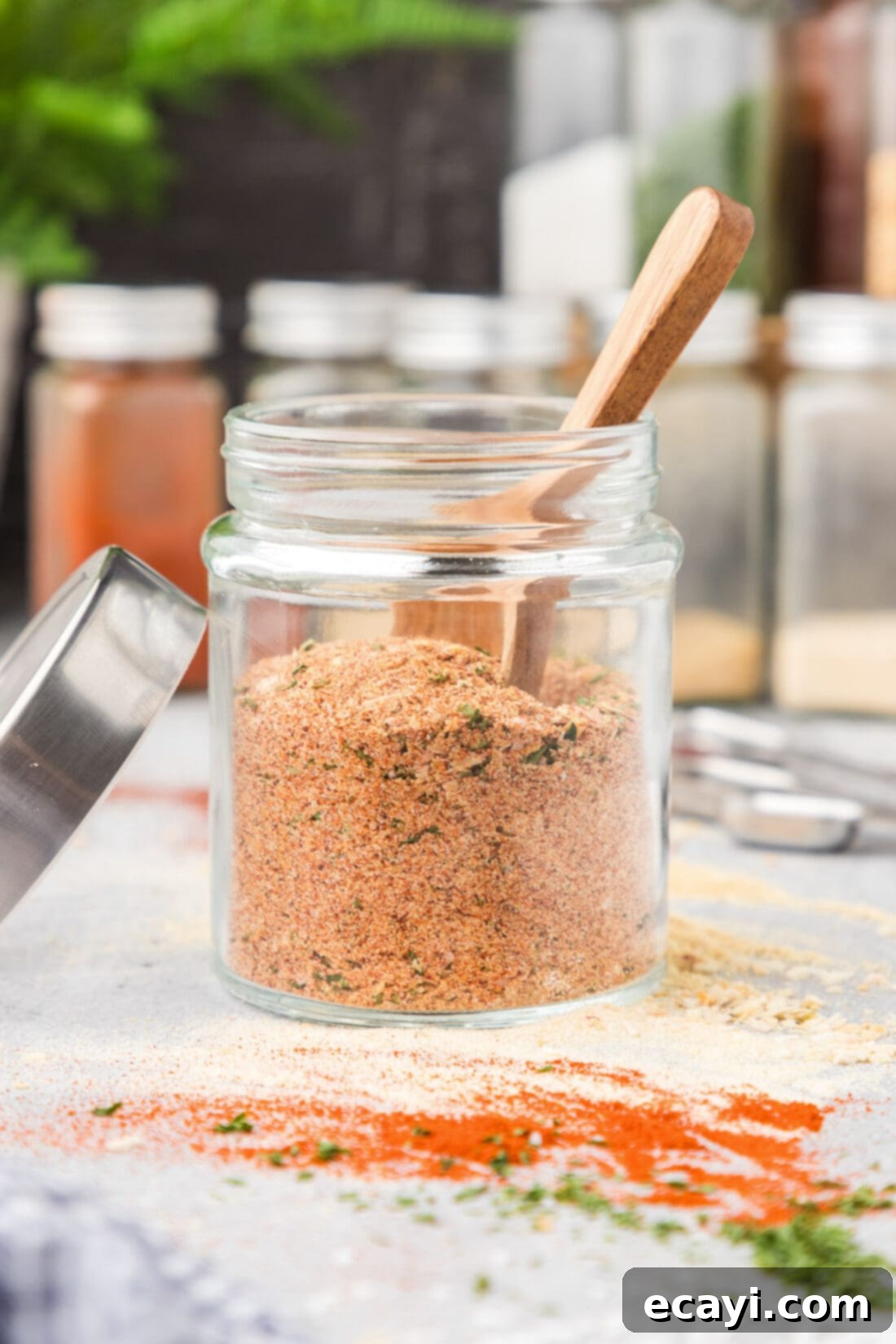
Why This Homemade All-Purpose Seasoning Is a Game Changer
This all-purpose seasoning truly earns its name, becoming an indispensable addition to any kitchen. Its magic lies in its perfectly balanced blend of flavorful spices and fragrant herbs, designed to infuse your meals with a rich, savory depth that tantalizes the taste buds. With just a quick shake or a generous rub, you can transform simple ingredients into dishes bursting with complex flavor. Its remarkable versatility means it’s an ideal companion for virtually any savory dish imaginable – from delicate seafood and robust pork to succulent beef, tender poultry, and vibrant roasted vegetables. Having this essential seasoning blend readily available in your pantry ensures you’re always just moments away from crafting a delicious, well-seasoned meal.
The decision to create your own homemade seasoning blends, such as this all-purpose mix, offers a multitude of benefits that extend far beyond mere convenience. Financially, it’s a savvy choice; purchasing individual spices in bulk and blending them yourself is significantly more cost-effective than repeatedly buying pre-mixed, often smaller, store-bought packets. Beyond the savings, it’s a huge time-saver in the long run. Prepping a batch once means you have a ready-to-use flavor booster for weeks or even months, eliminating the need to measure out multiple spices for every meal.
Our commitment to homemade blends stems from these advantages. Our pantry is always well-stocked with our favorite DIY variations, including Cajun seasoning, taco seasoning, and chili seasoning, alongside this stellar all-purpose mix, because these are the blends we find ourselves reaching for most frequently. But perhaps the most compelling reason to make your own is the unparalleled ability to customize. You dictate the exact ingredients, adjusting proportions to suit your personal palate, dietary needs, or to enhance specific dishes. This level of control ensures your food always tastes exactly how you want it – perfectly seasoned, every single time.
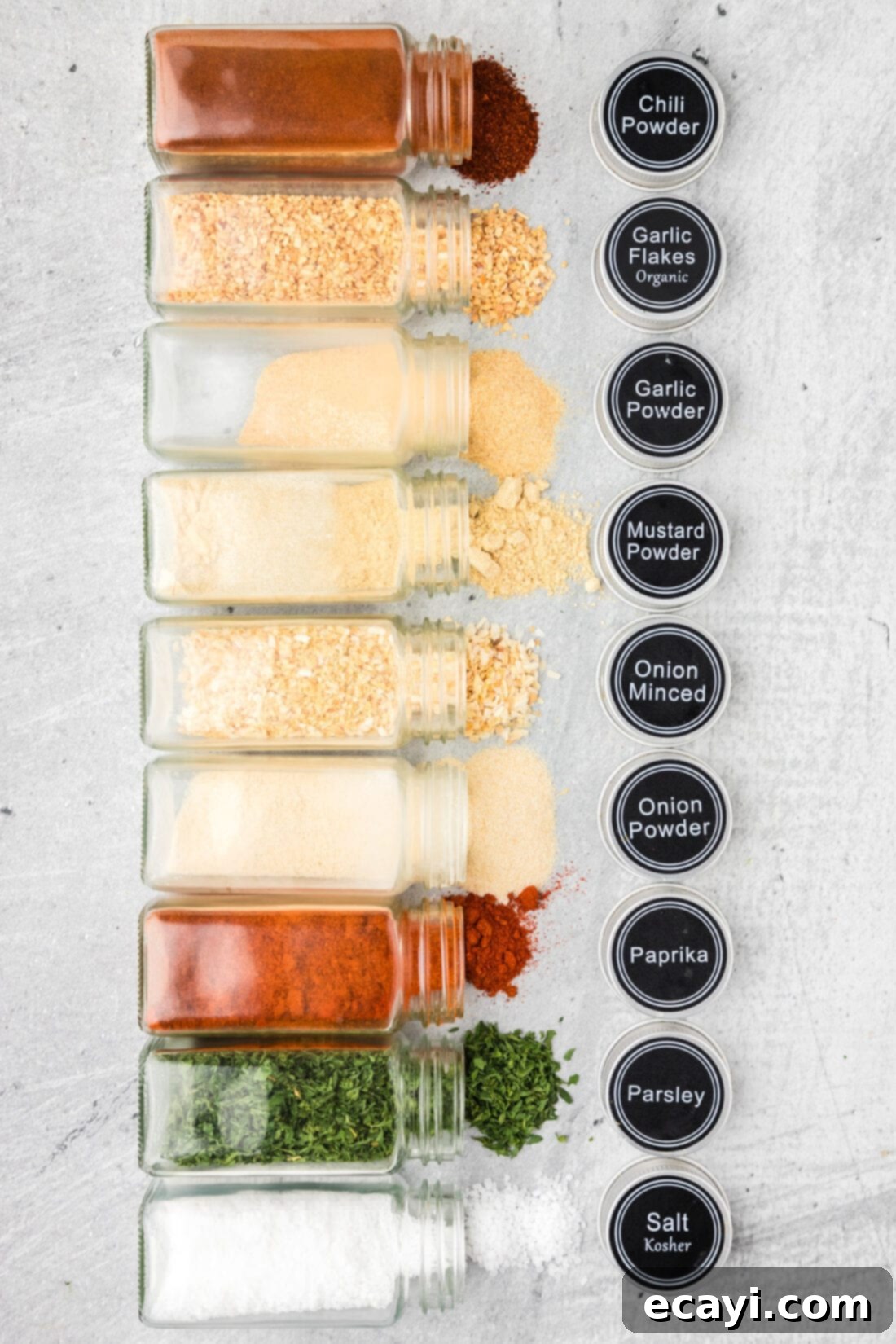
Ingredients You Will Need for This Flavorful Blend
Before you begin creating your masterful all-purpose seasoning, gather all the necessary ingredients. You’ll find a complete list of measurements, specific ingredients, and detailed instructions in the printable recipe card located at the conclusion of this comprehensive guide. Ensuring you have fresh, high-quality spices on hand will make all the difference in the vibrancy and depth of your final seasoning blend.
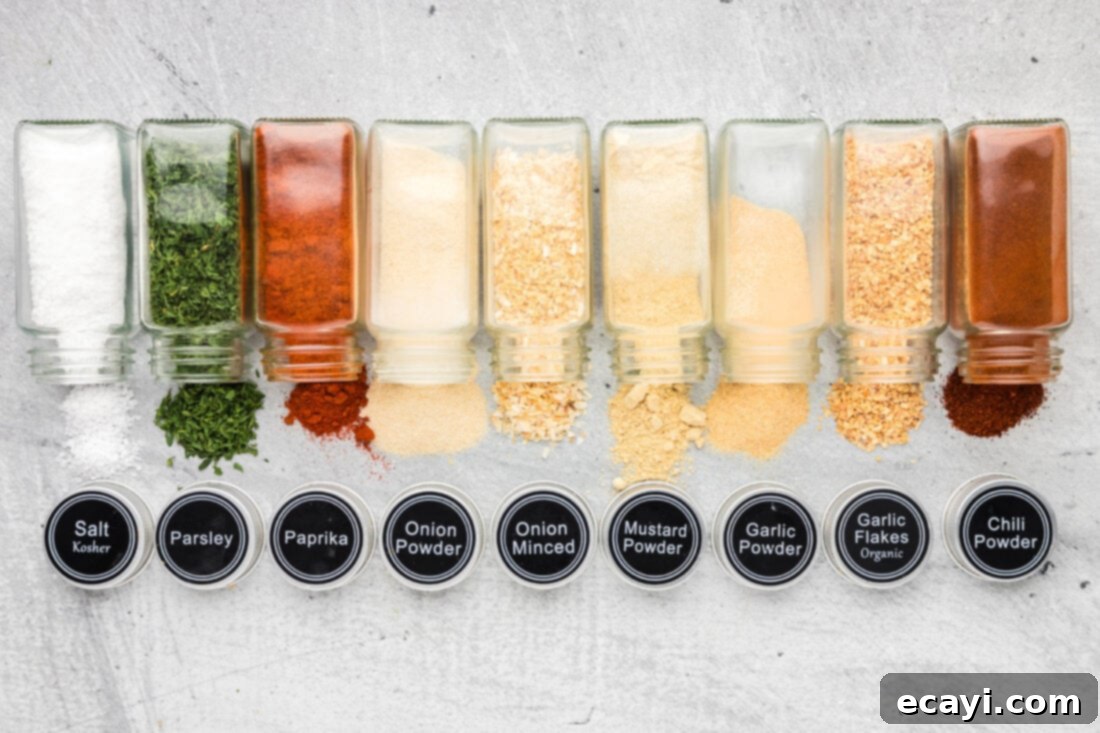
Key Ingredients for Your Signature All-Purpose Seasoning
The magic of this all-purpose seasoning lies in a thoughtful combination of pantry staples, each contributing its unique profile to create a balanced and robust flavor. Here’s a closer look at the “powerhouses” behind this incredible blend, along with insights into their roles and suggestions for substitutions or adjustments.
- Garlic Powder & Dried Minced Garlic: These two forms of garlic provide a dual layer of savory, pungent flavor. Garlic powder offers a fine, even distribution, while dried minced garlic adds textural interest and a more intense burst of garlic as it rehydrates during cooking. Together, they form the bedrock of this blend, imparting that essential aromatic depth.
- Substitution: While fresh garlic is fantastic, it’s not suitable for dried seasoning blends due to moisture content. If you only have one form, you can use either garlic powder or dried minced garlic, adjusting the quantity slightly to achieve your preferred intensity. For a milder garlic flavor, slightly reduce the amounts.
- Onion Powder & Dried Minced Onion: Similar to garlic, using both powder and minced onion ensures a comprehensive onion flavor. Onion powder disperses evenly, delivering a subtle sweetness and savory base, while dried minced onion offers a more pronounced onion character and a slight textural crunch. These are crucial for building a well-rounded savory profile and adding an umami depth.
- Substitution: Like garlic, stick to dried forms for shelf stability. You can use only onion powder if needed, increasing the amount slightly for equivalent flavor, though you’ll miss the texture of the minced variety.
- Chili Powder: This isn’t just for chili! Chili powder (which is often a blend of ground chiles, cumin, oregano, and garlic powder) adds an earthy, slightly smoky, and warm dimension without necessarily bringing intense heat. It contributes a rich, reddish hue to the blend and a comforting depth that works beautifully with various proteins and vegetables.
- Substitution: For a different flavor profile, try ancho chili powder for more smokiness and a fruitier note, or a mild paprika. If you desire more heat, refer to the cayenne pepper suggestion below.
- Paprika: Sweet paprika is typically used, offering a vibrant red color and a mild, sweet, and slightly peppery flavor. It enhances the visual appeal of dishes and provides a gentle warmth. Smoked paprika can be used as a fantastic alternative for an added layer of robust, complex, and smoky flavor, which is excellent on grilled meats, roasted vegetables, or anything needing a BBQ-like essence.
- Substitution: While sweet paprika is standard, hot paprika can be used for a spicier kick. Experiment with smoked paprika for a deeper, more rustic profile.
- Mustard Powder: This often-overlooked ingredient is a flavor secret weapon. Mustard powder adds a subtle tang, a pungent kick, and helps to brighten and round out the other savory notes in the blend. It works particularly well with meats, adding a subtle complexity that makes the blend truly all-purpose.
- Substitution: If you don’t have mustard powder, you can omit it, but you might notice a slight difference in the overall complexity and sharpness of the blend. There isn’t a direct dried substitute that provides the same unique tang and emulsifying properties.
- Dried Parsley: More than just a garnish, dried parsley contributes a fresh, herbaceous note that balances the heavier spices. It adds a subtle green fleck to the mix, signaling freshness and brightness, and offers a clean, slightly peppery flavor that complements most dishes.
- Substitution: Other dried herbs like oregano, thyme, marjoram, or even a touch of dried rosemary (used sparingly) could be considered for a different herbaceous profile, but parsley offers a universally appealing freshness that won’t clash with other flavors.
- Kosher Salt: Salt is fundamental for enhancing and awakening the flavors of all the other spices. Kosher salt is preferred for its larger flakes and clean taste, which allow for better control over seasoning and a less overwhelming salty taste compared to fine table salt. We purposefully keep the salt content moderate in this base recipe, empowering you to adjust it to your specific preference or dietary needs, especially if you’re seasoning something already salty (like brined poultry or cured meats).
- Substitution: Fine sea salt or regular table salt can be used, but you may need to adjust the quantity as they are denser and saltier by volume than Kosher salt. Start with less and add more if needed. For a low-sodium blend, reduce or omit the salt entirely and add it separately to your food when cooking.
The inherent beauty of this homemade all-purpose seasoning mix lies in its flexibility. Consider it a fantastic starting point, a robust foundation upon which you can build. You are the chef, and this recipe encourages experimentation! Feel free to adjust the quantities of any spice to better suit your personal taste preferences. If you crave more heat, a pinch or two of cayenne pepper or red pepper flakes will add that fiery kick. For an earthier blend, increase the chili powder or add a touch of cumin. If you’re seasoning delicate ingredients, you might want less garlic or onion. The power to customize is truly in your hands, allowing you to create a blend that is uniquely yours and perfectly suited for every culinary adventure.
Effortless Preparation: Making Your All-Purpose Seasoning
Creating your own batch of this fantastic all-purpose seasoning couldn’t be simpler. It requires minimal effort and no specialized equipment, making it a perfect project for even the most novice cooks. The beauty of this recipe lies in its straightforward approach: measure, combine, and store. For those who prefer visual guidance, accompanying step-by-step photos are provided throughout this post to illustrate each stage of the process. If you’re ready to jump straight to the full, printable recipe with precise measurements and detailed instructions, simply Jump to Recipe at the bottom of this page.
- Gather Your Ingredients: Before you begin, ensure all your chosen spices are fresh and accurately measured. Fresh spices yield the most potent and vibrant flavors, making a significant difference in your final blend.
- Combine All Spices: In a medium-sized bowl, pour in all the measured ingredients: garlic powder, onion powder, dried minced garlic, dried minced onion, chili powder, paprika, mustard powder, dried parsley, and Kosher salt. Make sure your bowl is large enough to allow for thorough mixing without spills.

- Mix Thoroughly: Using a whisk or a spoon, thoroughly combine all the spices. Stir vigorously for at least 1-2 minutes, ensuring that there are no clumps and that every ingredient is evenly distributed throughout the blend. This step is crucial for consistent flavor in every dish you season. You want a homogenous mixture so that each spoonful delivers the full spectrum of flavors.

- Store Properly: Once thoroughly mixed, transfer your fresh all-purpose seasoning blend into an airtight container. A glass jar with a tight-fitting lid or a sealed zip-top bag works perfectly. Label it with the date of preparation. Store the container in a cool, dry, and dark place, away from direct sunlight or heat, to preserve its potency and flavor for up to a year. While the blend may last longer, its aromatic intensity will gradually diminish over time.
Frequently Asked Questions & Expert Tips for Your All-Purpose Seasoning
To ensure you get the most out of your homemade all-purpose seasoning and keep it performing at its best, here are some common questions and valuable tips from our kitchen.
Proper storage is key to preserving the vibrant flavors of your seasoning blend. Always store your all-purpose seasoning in an air-tight jar or a sealed zip-top bag. The goal is to protect the spices from air, moisture, and light, which are the main culprits for flavor degradation. Keep the container in a cool, dry, and dark place, such as a pantry or a spice cabinet, away from direct sunlight, stove heat, or humidity. When stored correctly, the blend will maintain its peak potency for up to 1 year. While it might still be safe to use beyond this period, you may notice a gradual decrease in its aromatic intensity and overall flavor profile, so for best results, we recommend refreshing your batch annually.
Absolutely! This recipe is designed to be highly customizable. We purposely use a moderate amount of Kosher salt to give you flexibility. If you prefer a lower-sodium diet or are seasoning ingredients that are already salty (like brined poultry or processed meats), feel free to reduce the amount of salt or even omit it entirely from the blend. You can then add salt to your dishes separately during cooking, allowing for precise control. Conversely, if you enjoy a more robust salty kick, you can easily increase the Kosher salt to suit your taste. This control is one of the primary benefits of making your own blend!
For those who love a bit of heat, incorporating additional fiery elements is simple and encouraged. To introduce a noticeable warmth, add 1/2 to 1 teaspoon of cayenne pepper to the mix, depending on your preferred spice level. If you prefer a more textural heat and a slightly different flavor, consider including 1/2 to 1 teaspoon of red pepper flakes. Start with smaller amounts and gradually increase to reach your desired level of spice, as potency can vary between different brands and ages of chili products. You can also experiment with a dash of hot smoked paprika if you’re looking for smoky heat.
The quality of your seasoning blend begins with the freshness of your individual spices. Always aim to use high-quality, fresh spices. Whole spices tend to retain their potency longer than ground spices, so if you’re ambitious, consider grinding your own whole spices just before blending for an unparalleled aroma. When purchasing ground spices, check their expiration dates and buy them from reputable sources with good turnover. Storing individual spices correctly, in airtight containers away from heat and light, also contributes significantly to the longevity and vibrancy of your homemade blend. Avoid storing spices near the stove or dishwasher, where heat and humidity can quickly degrade their flavor.
Clumping can occur due to humidity or static electricity, especially with finely ground powders. To minimize this, ensure all your spices are completely dry before blending. If you live in a particularly humid environment, you might consider adding a food-grade desiccant packet to your storage jar, ensuring it does not come into direct contact with the spices. Another simple trick is to add a few grains of uncooked rice to the bottom of the jar (separated by a small piece of parchment paper if desired), which can help absorb excess moisture. Thoroughly mixing your blend and storing it in a cool, dry place as recommended will generally prevent clumping. If clumps do form, a quick shake of the jar or stirring with a dry spoon will usually break them up easily.
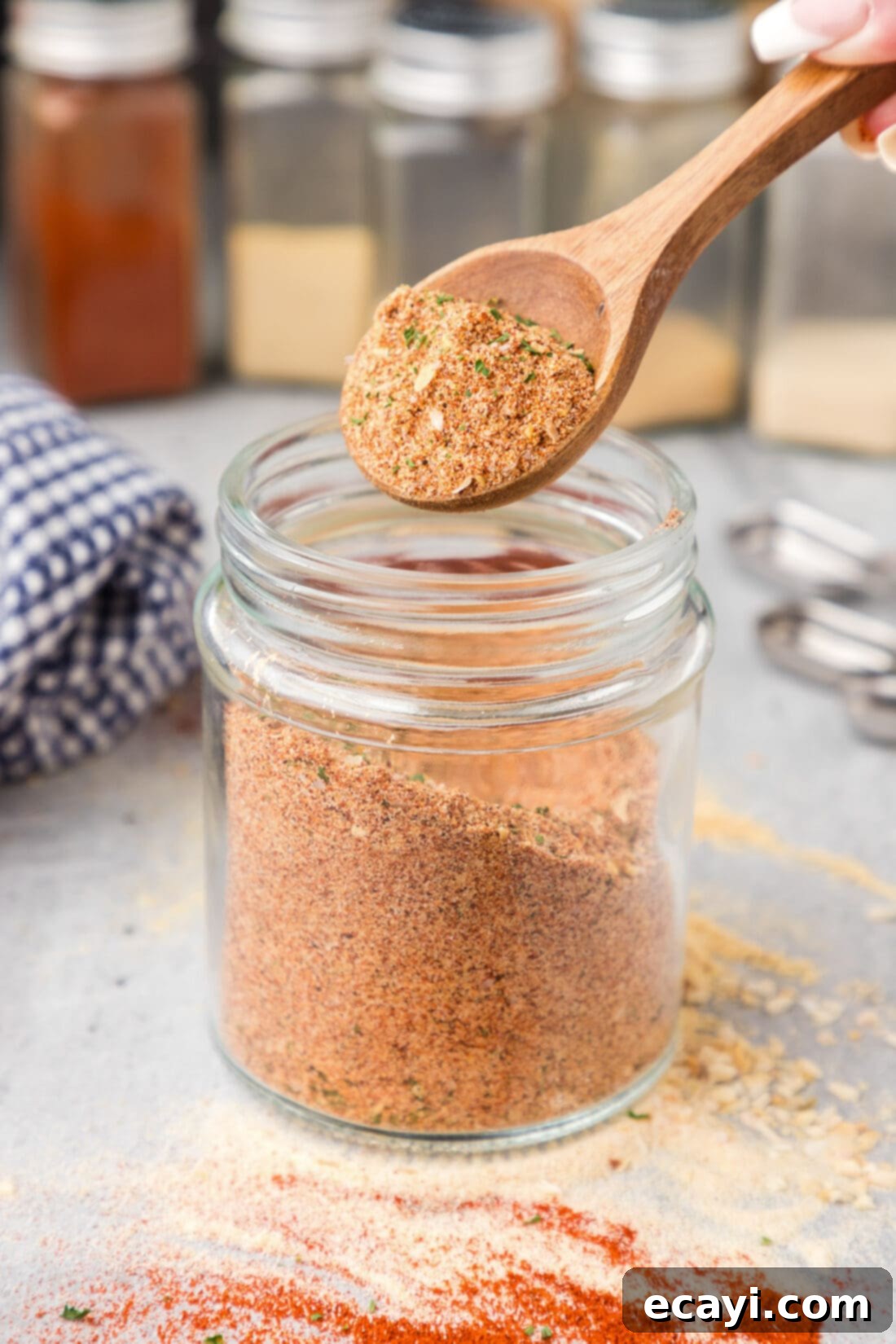
Versatile Uses: How to Enjoy Your All-Purpose Seasoning
The true genius of an all-purpose seasoning lies in its boundless applicability. This blend isn’t just a kitchen staple; it’s a culinary passport, capable of enhancing virtually any savory dish you can imagine. Its balanced flavor profile makes it incredibly adaptable, allowing it to shine across a wide spectrum of ingredients and cooking methods. Indeed, whenever you find yourself reaching for a savory seasoning, there’s a high probability this homemade blend will serve as an excellent, flavorful substitute, streamlining your cooking process and ensuring consistently delicious results.
Here are just some of the myriad ways you can incorporate this versatile seasoning into your daily cooking:
- Meats & Poultry:
- Rubs: Generously rub it onto cuts of pork, beef (steaks, roasts, brisket), chicken (whole, breasts, thighs, wings), or turkey before grilling, roasting, baking, or pan-searing. It creates a beautiful crust and infuses the meat with incredible flavor.
- Marinades: Whisk it into olive oil, a splash of vinegar, citrus juice, or yogurt to create a quick marinade for tenderizing and flavoring meats before cooking.
- Burgers & Meatballs: Mix it directly into ground beef, turkey, lamb, or even plant-based meat substitutes for incredibly flavorful burgers, meatballs, or meatloaf.
- Seafood:
- Grilled or Baked Fish: Sprinkle it liberally over fillets of salmon, cod, tilapia, halibut, or shrimp before grilling, baking, or pan-frying. It complements the delicate flavors of seafood without overpowering them.
- Seafood Sauté: A dash in your shrimp scampi, clam linguine, or other seafood sautés will add an extra layer of savory goodness and depth.
- Vegetables:
- Roasted Vegetables: Toss it with chopped vegetables like broccoli, cauliflower, carrots, potatoes (including sweet potatoes), zucchini, bell peppers, asparagus, or our favorite roasted Brussels sprouts with bacon before roasting. The heat of the oven helps to toast the spices, deepening their flavor.
- Sautéed Greens: Sprinkle it over sautéed spinach, kale, collard greens, or Swiss chard for a quick flavor boost that enhances their natural bitterness.
- Grilled Corn: Mix with softened butter and brush over grilled corn on the cob for an irresistible summer side.
- Soups, Stews & Casseroles:
- Flavor Base: Stir it into soups, hearty stews, warming chilis, and comforting casseroles during the cooking process to build a rich, savory foundation. It’s particularly good in chicken noodle soup, lentil soup, beef stew, or creamy potato casseroles.
- Creamy Dishes: Enhance the flavor of creamy sauces, gravies, gratins, and pasta sauces with a generous pinch.
- Snacks & Dips:
- Popcorn Seasoning: Sprinkle over freshly popped popcorn with a little melted butter for a gourmet savory snack.
- Dips & Spreads: Mix into plain yogurt, sour cream, cream cheese, or hummus for a quick and flavorful dip or sandwich spread.
- Roasted Nuts & Seeds: Toss with nuts or seeds and a touch of olive oil before roasting for a deliciously savory and addictive snack.
- Breakfast Foods:
- Eggs: A sprinkle over scrambled eggs, omelets, frittatas, or even deviled eggs can instantly elevate your breakfast or brunch.
- Hash Browns & Breakfast Potatoes: Season your homemade or frozen hash browns, home fries, or any breakfast potatoes for an extra kick of flavor.
This all-purpose seasoning empowers you to experiment and discover new flavor combinations across all your meals. Don’t be afraid to think outside the box and use it creatively; its versatility is truly its greatest asset, making every dish you prepare a testament to delicious, homemade flavor and a testament to your culinary prowess.
The Undeniable Benefits of Crafting Your Own Seasoning Blends
While the convenience of store-bought seasoning mixes is undeniable, the advantages of making your own at home are far more compelling and impactful for your health, wallet, and culinary creativity. Once you start blending your own, you’ll wonder why you ever did it any other way.
- Unmatched Flavor & Freshness: The most significant benefit is the superior flavor. Commercial blends often sit on shelves for extended periods, and their ingredients can lose potency. By making your own, you’re using fresh, vibrant spices that deliver a much more aromatic and intense flavor profile to your dishes. You control when it’s made, ensuring peak freshness. The difference in taste is immediately noticeable and truly transforms your cooking.
- Complete Control Over Ingredients: This is crucial for health-conscious cooks. Store-bought seasonings frequently contain hidden additives like anti-caking agents (which can be unhealthy), MSG, excessive sugar, artificial colors, or unhealthy oils and preservatives. When you make your own, you know exactly what goes into it – just pure, high-quality spices and herbs. This is particularly beneficial for those with allergies, specific dietary restrictions (such as gluten-free or keto), or simply a desire for clean eating without unnecessary chemicals.
- Customization to Your Palate: No two palates are exactly alike, and what one person considers perfectly seasoned, another might find bland or too intense. With homemade blends, you’re the master chef. Want more garlic? Less salt? A spicier kick with extra cayenne? A hint of unique flavor with a different dried herb? You can fine-tune every ingredient to suit your personal preferences, your family’s tastes, or the specific dish you’re preparing. This level of customization is simply not possible with pre-packaged options.
- Significant Cost Savings: Buying individual spices in larger quantities from bulk bins or ethnic markets is almost always more economical in the long run than repeatedly purchasing small, often overpriced, pre-mixed packets. A single investment in a few common spices can yield many batches of various blends, saving you considerable money over time, especially if you cook frequently.
- Reduced Sodium Intake: Many commercial seasoning blends are notoriously high in sodium, often using salt as a primary filler. By making your own, you can drastically reduce the salt content, or even omit it entirely, adding salt separately to taste during cooking. This is a game-changer for those managing blood pressure, watching their sodium intake, or simply seeking healthier eating habits without sacrificing flavor.
- Environmental Friendliness: Opting for homemade blends often means buying spices in bulk or larger, reusable containers, significantly reducing the amount of single-use plastic packaging that comes with individual seasoning packets. This small change contributes to a more sustainable kitchen and reduces your carbon footprint.
- Empowerment & Culinary Skill Development: Blending your own spices demystifies the art of seasoning and empowers you in the kitchen. It encourages you to understand different flavor profiles, how they interact, and how they contribute to the overall taste of a dish, boosting your confidence and expanding your culinary repertoire. You’ll develop a more intuitive sense of taste and balance, becoming a more skilled and creative cook.
In essence, creating your own all-purpose seasoning isn’t just about saving money; it’s about investing in superior flavor, better health, and a more fulfilling and creative cooking experience. It’s a simple step that yields profound benefits, transforming your everyday meals into something truly special and uniquely yours.
More Homemade Seasoning Recipes to Explore
Once you discover the joy and benefits of making your own all-purpose seasoning, you’ll likely want to expand your homemade spice blend collection. Here are more fantastic recipes to keep your pantry stocked with flavorful, customizable mixes for every culinary need:
- Homemade Italian Seasoning
- Flavorful French Fry Seasoning
- Easy Homemade Chili Seasoning
- Classic Homemade Taco Seasoning Mix
- Creative Popcorn Seasonings
- Zesty Shrimp Seasoning
I love to bake and cook and share my kitchen experience with all of you! Remembering to come back each day can be tough, that’s why I offer a convenient newsletter every time a new recipe posts. Simply subscribe and start receiving your free daily recipes!
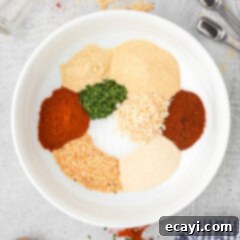
All Purpose Seasoning
IMPORTANT – There are often Frequently Asked Questions within the blog post that you may find helpful. Simply scroll back up to read them!
Print It
Pin It
Rate It
Save ItSaved!
Ingredients
- 2 Tablespoons garlic powder
- 1 Tablespoon onion powder
- 1 Tablespoon dried minced garlic
- 1 Tablespoon dried minced onion
- 1 Tablespoon chili powder
- 1 Tablespoon paprika
- 2 teaspoons mustard powder
- 2 teaspoons dried parsley
- 2 teaspoons Kosher salt
Things You’ll Need
-
Mixing bowl
-
Air tight container such as a jar or sealed ziptop bag
Before You Begin
- The exceptional beauty of this all-purpose seasoning mix lies in its adaptability. Consider it a versatile starter, a robust foundation upon which you can build your culinary creations. You are encouraged to adjust the levels of spices according to your personal taste preferences or even substitute ingredients as you see fit to perfectly match your dish. For instance, we’ve kept the salt content moderate in this base mix, giving you the freedom to increase it if you desire a saltier profile or reduce it for a low-sodium option. For those who enjoy a fiery kick, the addition of a pinch of cayenne pepper or red pepper flakes will transform this blend into a spicier sensation.
- For optimal freshness and potency, ensure you store your all-purpose seasoning blend correctly. Transfer it into an air-tight jar or a securely sealed zip-top bag. It’s crucial to keep the container in a cool, dry place, shielded from direct sunlight or any sources of heat or humidity. This method will help preserve its vibrant flavor and aromatic strength for up to 1 year. While the blend will remain usable past a year, its efficacy and pungency may gradually diminish, so for the best flavor, aim to refresh your batch annually.
- Pro Tip: Toasting Whole Spices (Optional): For an even deeper and more complex flavor, consider gently toasting any whole spices you might be using (like whole cumin seeds before grinding, or whole peppercorns) in a dry pan over medium-low heat for a few minutes until fragrant, before grinding and adding them to the blend. This process awakens their essential oils and intensifies their aroma. However, this step is entirely optional and the blend is fantastic without it!
- Ensuring Even Distribution: When combining your ingredients, don’t just give them a quick stir. Whisk them vigorously for a full minute or two. This ensures that the finer powders don’t settle at the bottom and that every single ingredient is uniformly distributed throughout the blend, guaranteeing consistent flavor with every shake.
Instructions
-
Combine all ingredients in a bowl. Whisk thoroughly for 1-2 minutes until all spices are evenly distributed. Cover with a tight-fitting lid and store in a cool, dry, dark place for up to a year.
Nutrition
The recipes on this blog are tested with a conventional gas oven and gas stovetop. It’s important to note that some ovens, especially as they age, can cook and bake inconsistently. Using an inexpensive oven thermometer can assure you that your oven is truly heating to the proper temperature. If you use a toaster oven or countertop oven, please keep in mind that they may not distribute heat the same as a conventional full sized oven and you may need to adjust your cooking/baking times. In the case of recipes made with a pressure cooker, air fryer, slow cooker, or other appliance, a link to the appliances we use is listed within each respective recipe. For baking recipes where measurements are given by weight, please note that results may not be the same if cups are used instead, and we can’t guarantee success with that method.
